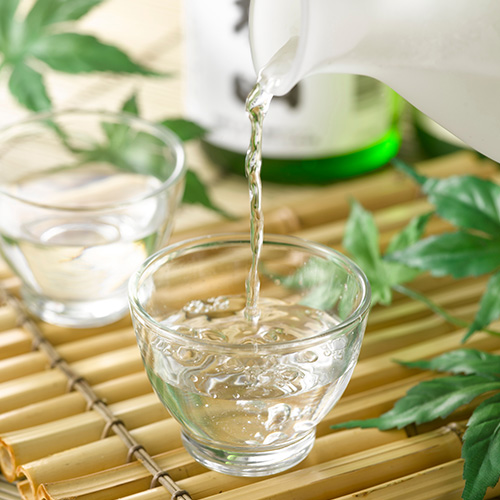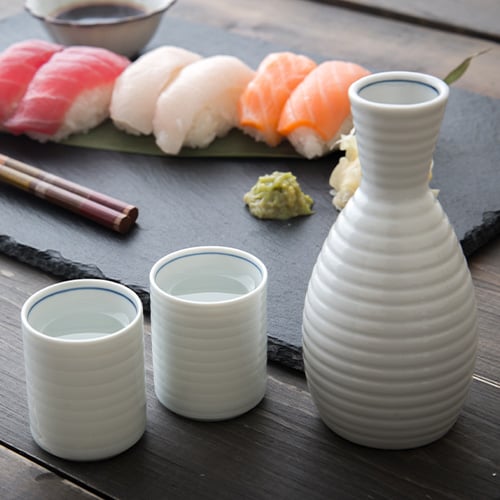Sake is a major trend in the United States, as the country is now the largest importer of sake and the biggest non-Japanese sake market. This makes sake the perfect menu addition for successful bars and restaurants that are looking to expand. Integrating sake into your establishment’s menu allows you to diversify your offerings to serve new customers. Below, we’ll show you how to correctly serve and drink sake, allowing you to properly introduce the Japanese beverage to customers.
Shop All Sake Cups and BottlesWhat Is Sake?
Sake is an alcoholic beverage made from fermented rice, originally made in Japan. In Japanese, the word sake refers to any alcoholic beverage, while in English the word sake refers to a specific alcoholic drink. Sake has always been popular in its country of origin, being recognized as Japan’s national beverage. People often serve and drink sake during special Japanese ceremonies, intertwining the beverage with local culture.

Sake Pronunciation
The correct pronunciation of Sake is “sah-keh”. Sake is commonly mispronounced as “sah-kee” by many English speakers. Just make sure to pronounce the end of the word with a short "e" to get close to the Japanese pronunciation of the word.
What Is Sake Made Of?
Sake is an alcoholic beverage made primarily from rice. Sake rice is larger and stronger than table rice, allowing it to be polished. A fungus known as koji-kin is spread across the rice, aiding in saccharification and fermentation, two key processes in the making of alcoholic beverages. Water is also heavily used in every stage of making sake, being utilized to clean the rice before fermentation and to dilute the beverage at the end.
How to Serve Sake

There are several Japanese customs related to serving sake, and they are quite unique when compared to serving other alcoholic beverages in America. Traditionally, sake isn’t poured by a waiter but rather by others in your group, creating a community experience. Here is how to serve sake:
- Select the proper beverageware. Sake should be placed in a tokkuri (a pouring vessel with a bulbous bottom and long, thin neck) when serving. Sake should be poured from the tokkuri into an ochoko (a tiny, shot glass-sized cup) or a hirahai (a tiny, wide-mouthed cup) for guests.
- Adjust the temperature. Sake should be heated, chilled, or served at room temperature depending on the sake you are serving. For example, ginjo sake is best served slightly chilled to bring out its delicate fragrance, while a sake like junmai may taste better slightly warm, bringing out its richer notes.
- Fill the ochoko. Sake should be poured with both hands, with the right hand holding the tokkuri and the left hand supporting from the bottom. Pour the sake so that it fills to the top of the cup. When receiving sake, you should hold out your ochoko with one hand while supporting the bottom with your other.
- Do not pour your own glass. In Japanese culture, pouring your own sake is considered unmannerly, so allow others to pour for you. Pouring sake for others and receiving the same in return is a way to show appreciation for each other’s company in Japanese culture and creates a community environment for all to enjoy.
- Refill at appropriate times. Traditionally, others are offered a fresh pour of sake when their cups are less than one-third full. There is a lot of courtesy and hospitality around drinking sake in traditional Japanese culture, so it is important to be mindful of when those around you might want more sake.
Sake Glasses
Sake is an important part of Japanese culture, and as a result there is special glassware used in the drinking and serving of the beverage. Many of these items are unique, and will only be encountered when enjoying sake. Here are some of the glasses you should know about before serving and drinking sake.
- Tokkuri - Tokkuri is a serving tool for sake, being transferred from the bottle to the tokkuri before then being poured to drink. Heated sake can be warmed by placing the tokkuri in a pan of hot water, with tokkuri’s long neck trapping heat and keeping the sake warm.
- Ochoko - A small circular cup that resembles a shot glass. Ochokos are very small and are one of the most common vessels for enjoying sake. However, just because an ochoko is small doesn’t mean that sake served in one should be drunk like a shot.
- Masu - A masu is sometimes used in tandem with an ochoko to serve sake. A masu is a palm-sized square container and an ochoko is usually placed inside. The ochoko is then deliberately overfilled, with the excess pouring into the masu. Customarily patrons will drink the sake in the ochoko before finishing the excess in the masu.
- Hirahai - Hirahai are cups that are similar to flat ochokos. The small size and flat rims of hirahi make them the perfect vessel for tasting sake in small amounts.
How to Serve Sake Video
To learn how to properly pour sake for guests, watch the video below for a step-by-step guide:
How to Drink Sake
Just like with serving sake, there are several traditions around drinking sake. Practicing the way that sake is traditionally drunk shows respect for Japanese culture and allows you to get the full experience from the drink. Here is how to drink sake:
- Hold ochoko properly. The ochoko should be held with two hands when drinking.
- Wait to start. Everyone should be served before you begin drinking.
- Kanpai! Once everyone has been served, say “Kanpai”, the Japanese equivalent of a toast or cheers, and begin drinking.
- Drink in small sips. Drink your sake in small sips similar to how you would drink brandy, rather than gulping it down quickly like a shot. Let the sake sit in your mouth for a little before swallowing, allowing you to fully enjoy the drink's flavor.
What Does Sake Taste Like?
Sake is a very light and smooth drink, allowing it to easily go down when drunk. You’ll experience an umami flavor from the drink’s high acidity. The flavor may sit for a short period, as sake is known to leave a bit of an after-taste. When comparing sake’s taste to other alcoholic beverages, sake’s flavor is most similar to wine.
Types of Sake
Just like there are different types of beers, liquors, and wines, there also are different types of sake. These variations differ in creation, taste, and texture, leading to a variety of fantastic sake types. If you plan on serving sake at your bar or restaurant, here are some of the most common types patrons will be interested in:
- Junmai - Sake that is made from pure rice and contains no brewers' alcohol (a neutral distilled spirit) is known as junmai. Junmai can be served cold (40-60 degrees Fahrenheit), at room temperature (70 degrees Fahrenheit), or warm (85-105 degrees Fahrenheit).
- Honjozo - Honjozo is sake that has brewers' alcohol added, creating a smooth flavor and aroma. Honjozo can be served cold (40-60 degrees Fahrenheit), at room temperature (70 degrees Fahrenheit), or warm (85-105 degrees Fahrenheit).
- Daiginjo and Junmai Daiginjo - Daiginjo is made with a rice polishing ratio of over 50%. Junmai Daiginjo is the same, yet made without brewers' alcohol. Daiginjo and Junmai Daiginjo can be served cold (40-60 degrees Fahrenheit) or at room temperature (70 degrees Fahrenheit).
- Ginjo and Junmai Ginjo - Ginjo is brewed with rice grains polished down to 60% junmai. Ginjo is the same yet made without brewers’ alcohol. Ginjo and Junmai Ginjo can be served cold (40-60 degrees Fahrenheit) or at room temperature (70 degrees Fahrenheit).
- Futsushu - Futsushu translates to ordinary sake in English. This type of sake makes up the majority of affordable sake in Japan. Futsushu can be served cold (40-60 degrees Fahrenheit), at room temperature (70 degrees Fahrenheit), or warm (85-105 degrees Fahrenheit).
How to Warm Sake
Sake can be warmed by being poured into a tokkuri and placed in boiling water. The tokkuri’s long neck traps heat, keeping the sake warm until served. Heat your sake until it reaches between 220-235 degrees Fahrenheit, depending on the type of sake. Sakes that have savory and earthy flavors are usually warmed, making types like junmai and honjozo perfect candidates.
Back to TopSake FAQ
We cover some of the most common questions regarding sake below:
What Is Saki?
Saki is a common misspelling of sake, but many people get confused and believe they are two separate items. Saki should never be used interchangeably with sake, as it is an incorrect spelling of the word. Spelling and pronouncing sake as saki can lead to some confusion, especially in traditional Japanese establishments.
Is Sake Good for You?
Because sake is alcohol, it carries all of the same risk factors. Short-term effects include alcohol poisoning, pregnancy complications, and medication disruptions, to name a few. Long-term effects include strokes, liver disease, and heart disease.
What Is a Sake Bomb?
A sake bomb is a drink made by dropping a shot glass of sake into a glass of beer. The drink’s origins are said to come from American soldiers stationed in Japan after World War II, placing an American twist on the drink. Traditionally, the sake would be balanced on two chopsticks and drunk immediately once the chopsticks are removed and the sake falls into the beer. Although sake is a traditional Japanese drink, sake bombs are usually only enjoyed in America.

How Long Does Sake Last?
Sake oxidizes after opening, but not as quickly as wine. To prolong sake’s life, only drink it within a week after opening it and store it in the refrigerator. If the sake is unopened, you’ll want to consume it sometime within the first 12 months.
Sake Alcohol Content
On average sake has a high alcohol content, with a typical sake hovering around 15-17% alcohol by volume (ABV). Sake will usually have a higher ABV than other drinks such as beer, hard cider, and wine, but isn’t as strong as hard liquors. Undiluted sake typically has an ABV between 18-20%, being slightly stronger. The relatively high alcohol content of sake makes the drink perfect when you want something stronger than beer, but don’t want hard liquor.
Is Sake Strong?
Because of its ABV, sake is stronger than beer, cider, and wine, but does not have as high of an ABV as hard liquors. Sake is not a hard liquor. Hard liquor, such as whiskey varieties, gin, and brandy, are distilled. Sake is brewed, making it more closely related to beer.
What Goes Well with Sake?
Sake pairs with an array of different foods, and not just Asian dishes. Foods like cheeses, sushi and sashimi, and shellfish are among some of the most common sake pairings. The drink also pairs well with melon, ramen, and fried foods.
Back to TopWhether you’re starting a new bar or are just trying to appeal to new tastes, sake can be a fantastic addition to your alcohol menu. Sake is a delicious beverage with a uniqueness that sets it apart from other alcoholic beverages. When properly served and drank, your establishment can simultaneously honor the traditions centered around drinking sake while introducing the drink to new customers.



